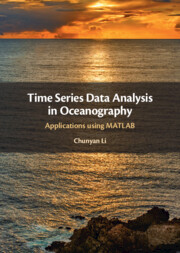Book contents
- Time Series Data Analysis in Oceanography
- Time Series Data Analysis in Oceanography
- Copyright page
- Contents
- Preface
- Acknowledgments
- 1 Introduction
- 2 Introduction to MATLAB
- 3 Time and MATLAB Functions for Time
- 4 Deterministic and Random Functions
- 5 Error and Variability Propagation
- 6 Taylor Series Expansion and Application in Error Estimate
- 7 Spherical Trigonometry and Distance Computation
- 8 A System of Linear Equations and Least Squares Method
- 9 Base Functions and Linear Independence
- 10 Generic Least Squares Method and Orthogonal Functions
- 11 Harmonic Analysis of Tide
- 12 Fourier Series
- 13 Fourier Transform
- 14 Discrete Fourier Transform and Fast Fourier Transform
- 15 Properties of Fourier Transform
- 16 More Discussion on the Harmonic Analysis and Fourier Analysis
- 17 Effect of Finite Sampling
- 18 Power Spectrum, Cospectrum, and Coherence
- 19 Window Functions for Reducing Side Lobes
- 20 Convolution, Filtering with the Window Method
- 21 Digital Filters
- 22 Rotary Spectrum Analysis
- 23 Short-Time Fourier Transform and Introduction to Wavelet Analysis
- 24 Empirical Orthogonal Function Analysis
- References
- Index
13 - Fourier Transform
Published online by Cambridge University Press: 21 April 2022
- Time Series Data Analysis in Oceanography
- Time Series Data Analysis in Oceanography
- Copyright page
- Contents
- Preface
- Acknowledgments
- 1 Introduction
- 2 Introduction to MATLAB
- 3 Time and MATLAB Functions for Time
- 4 Deterministic and Random Functions
- 5 Error and Variability Propagation
- 6 Taylor Series Expansion and Application in Error Estimate
- 7 Spherical Trigonometry and Distance Computation
- 8 A System of Linear Equations and Least Squares Method
- 9 Base Functions and Linear Independence
- 10 Generic Least Squares Method and Orthogonal Functions
- 11 Harmonic Analysis of Tide
- 12 Fourier Series
- 13 Fourier Transform
- 14 Discrete Fourier Transform and Fast Fourier Transform
- 15 Properties of Fourier Transform
- 16 More Discussion on the Harmonic Analysis and Fourier Analysis
- 17 Effect of Finite Sampling
- 18 Power Spectrum, Cospectrum, and Coherence
- 19 Window Functions for Reducing Side Lobes
- 20 Convolution, Filtering with the Window Method
- 21 Digital Filters
- 22 Rotary Spectrum Analysis
- 23 Short-Time Fourier Transform and Introduction to Wavelet Analysis
- 24 Empirical Orthogonal Function Analysis
- References
- Index
Summary
This chapter discusses the transition between Fourier series and Fourier Transform, which is the tool for spectrum analysis. Generally, the use of linearly independent base functions allows a wide range of linear regression models that work in a least square sense such that the total error squared is minimized in finding the coefficients of the base functions. A special case is sinusoidal functions based on a fundamental frequency and all its harmonics up to infinity. This leads to the Fourier series for periodic functions. In this chapter, we start from the original Fourier series expression and convert the sinusoidal base functions to exponential functions. We can then consider the limit when the length of the function and the period of the original function approach infinity (so that the fundamental frequency approaches 0, including aperiodic functions), leading to the Fourier integral and Fourier Transform. We can then define the inverse Fourier Transform and establish the relationship between the coefficients of Fourier series and the discrete form Fourier Transform. All these are preparations for the fast Fourier Transform (FFT), an efficient algorithm of computation of the discrete Fourier Transform that is widely used in data analysis for oceanography and other applications.
Keywords
- Type
- Chapter
- Information
- Time Series Data Analysis in OceanographyApplications using MATLAB, pp. 230 - 241Publisher: Cambridge University PressPrint publication year: 2022



